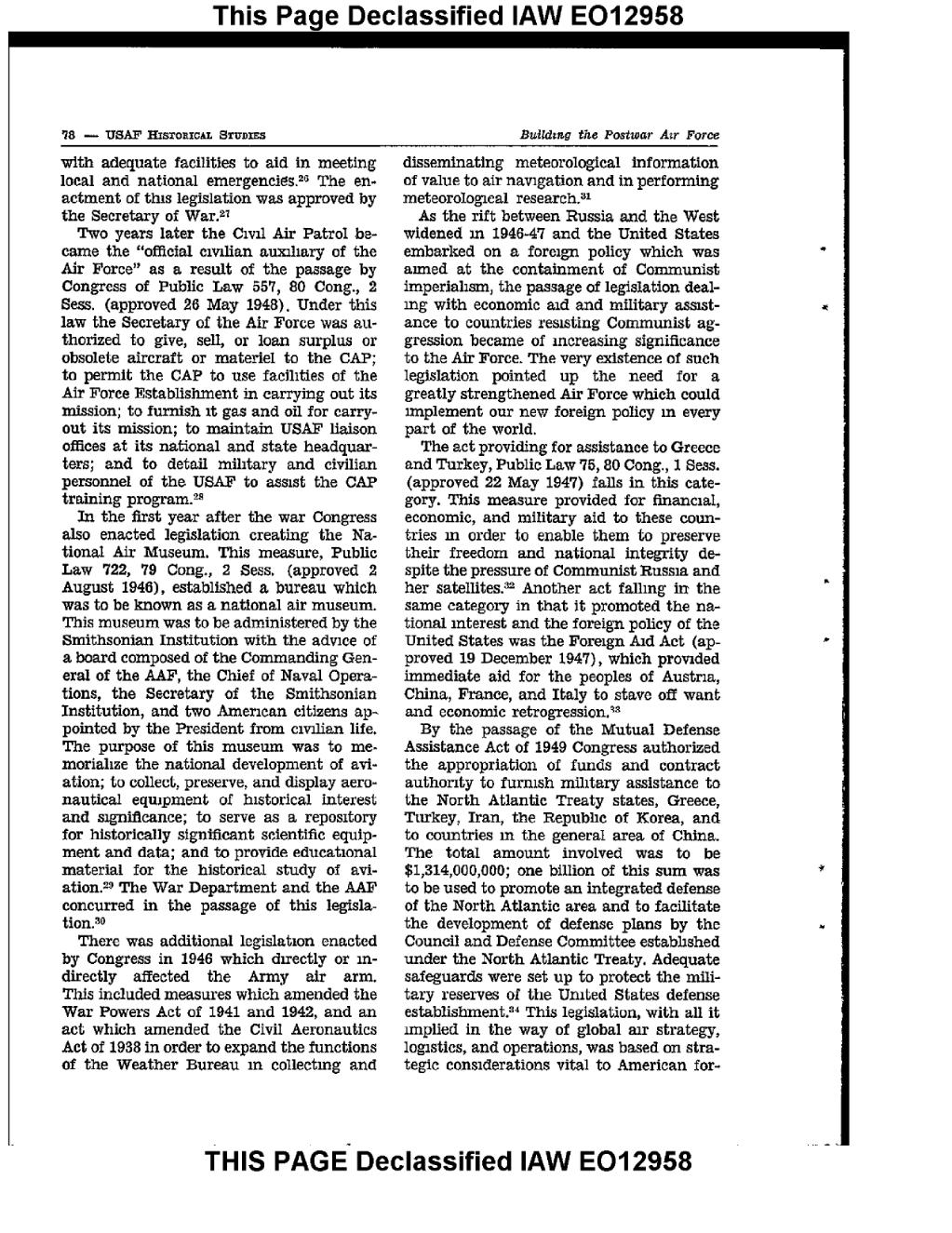�This Page Declassified lAW EO12958 ?8 ? USAF P?SrO?CA[ with adequate facilities to aid in meeting local and national emergencies. 2? The en- actment of th,s legislation was approved by the Secretary of War.? Two years later the Cxwl Air Patrol be- came the "official civilian auxiliary of the Air Force" as a result of the passage by Congress of Public Law 557, 80 Cont., 2 Sess. (approved 26 May 1948). Under this law the Secretary of the Air Force was au- thorized to give, sell, or loan surplus or obsolete aircraft or materiel to the CAP; to permit the CAP to use facilities of the Air Force Establishment in carrying out its mission; to furnish it gas and oil for carry- out its mission; to maintain USAF liaison offices at its national and state headquar- ters; and to detail mihtary and civilian personnel of the USAF to assist the CAP training program. ?s In the first year after the war Congress also enacted legislation creating the Na- tional Air Museum. This measure, Public Law ?22, 79 Cont., 2 Sess. (approved 2 August 1946), established a bureau which was to be known as a national air museum. This museum was to be administered by the Smithsonian Institution with the advice of a board composed of the Commanding Gen- eral of the AAF, the Chief of Naval Opera- tions, the Secretary of the Smithsonian Institution, and two American citizens ap? pointed by the President from civilian life. The purpose of this museum was to memorialize the national development of aviation; to collect, preserve, and display aero-nautical equipment of historical interest and s?gnificance; to serve as a repomtory for historically significant scientific equip- ment and data; and to provide educational material for the historical study of avi- ation.? The War Department and the AAF concurred in the passage of this legisla- tion.? There was additional legislation enacted by Congress in 1946 which d[rectly or m- directly affected the Army air arm. This included measures which amended the War Powers Act of 1941 and 1942, and an act which amended the Civil Aeronautics Act of 1938 in order to expand the functions of the Weather Bureau m collecting and disseminating meteorological information of value to air namgation and in performing meteorologmal research.? As the rift between Russia and the West widened m 1946-4? and the United States embarked on a formgn policy which was anned a? the containment of Communist imperiahsm, the passage of legislation deal- mg with economic aid and military assast- ance to countries resisting Communist ag- gression became of increasing significance to the Air Force. The very existence of such legislation pointed up the need for a greatly strengthened Air Force which could implement our new foreign policy ?n every part of the world. The act providing for assistance to Greece and Turkey, Public Law ?5, 80 Cont., 1 Sess. (approved 22 May 1947) falls in this cate- gory. This measure provided for finunreal, economic, and military aid to these coun- tries m order to enable them to preserve their freedom and national integrity de- spite the pressure of Communist Russm and her satellites. ? Another act falling i? the same category in that it promoted the na- tional interest and the foreign policy of the United States was the Foreign Aid Act (ap- proved 19 December 1947), which prowded immediate aid for the peoples of Austria, China, France, and Italy to stave off want and economic retrogressionJ ? By the passage of the Mutual Defense Assistance Act of 1949 Congress authorized the appropriation of funds and contract authority to furrash mihtary assistance to the North Atlantic Treaty states, Greece, Ttrrkey, Iran, the Repubhc of Korea, and to countries ?n the general area of China. The total amount involved was to be $1,314,0(]0,000; one billion of this sum was to be used to promote an integrated defense of the North Atlantic area and to facilitate the development of defense plans by the Council and Defense Committee estabhshed under the North Atlantic Treaty. Adequate safeguards were set up to protect the mili- tary resexwes ol the United States defense establishment. s? This legislation, with all it ?mplied in the way of global mr strategy, logistics, and operations, was based on stra- tegic considerations vital to American for- THIS PAGE Declassflied lAW EO12958
